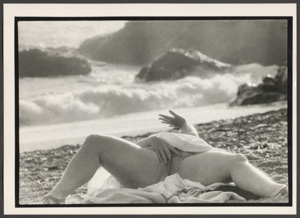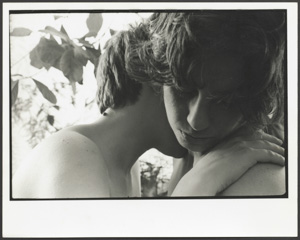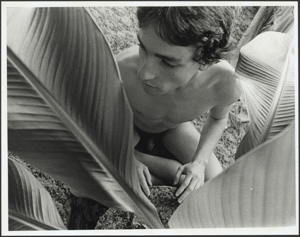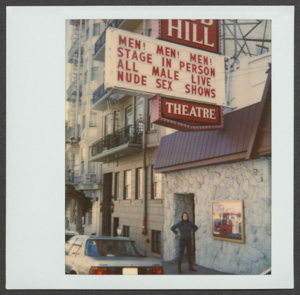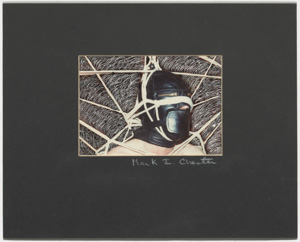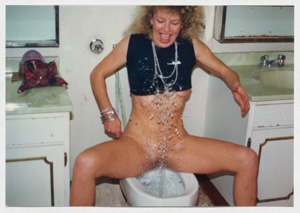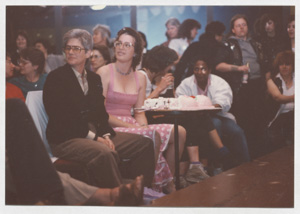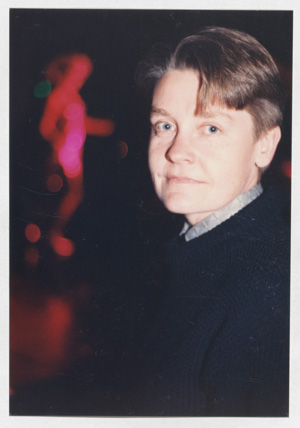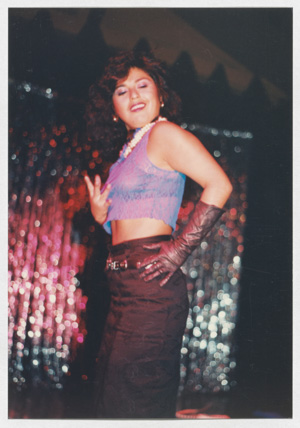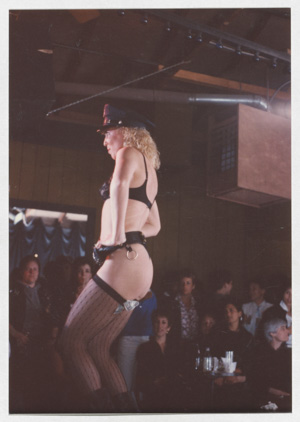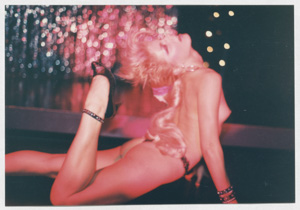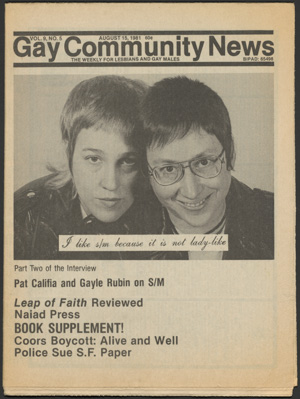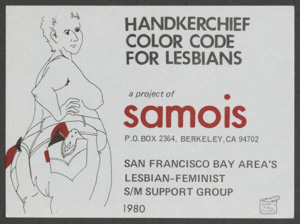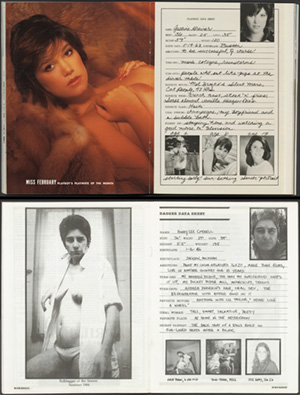Erotic Milieux
Nature
Multiple erotic traditions informed the women of On Our Backs. Connections to nature feature in a lot of earlier lesbian feminist erotica. Photographers Honey Lee Cottrell (1946–2015) and Tee Corinne (1943–2006) were lovers in the 1970s, and each of them explored the sensuality of nature. Gorgeous examples are Cottrell’s 1976 photograph of Lee Ray at San Francisco’s Ocean Beach, her 1982 portrait of sex education activist Jim Garver, and Corinne’s photograph of two women with leaves. At the same time that these images are authentically erotic, Corinne remembered that “she started shooting erotic pictures of hands and flowers for the feminist press because they simply wouldn’t publish her studies of female nudes or genitals.”[1]
Honey Lee Cottrell, LR at the beach, 1976.
Gelatin silver print
Honey Lee Cottrell papers
Collection/Call #: 7822
Box: 8 | Folder: 5
(1 image)
Tee A. Corinne. Two women with leaves, 1975.
Gelatin silver print
Honey Lee Cottrell papers
Collection/Call #: 7822
Box: 9 | Folder: 64
(1 image)
Honey Lee Cottrell. [Jim Garver of the National Sex Forum], 1982.
Gelatin silver print
Honey Lee Cottrell papers
Collection/Call #: 7822
Box: 8 | Folder: 8
(1 image)
Gay men’s erotic businesses & traditional strip tease
The On Our Backs creators had connections with gay male-oriented erotic bars, bath houses, and theaters. Historian Allan Bérubé wrote that “in a nation which has for generations mobilized its institutions toward making gay people invisible, illegal, isolated, ignorant and silent, gay baths and bars became the first stages of a movement of civil rights for gay people in the United States.”[2] The AIDS crisis made it a larger challenge to maintain sex-positive spaces. The owners and staff took additional measures to encourage safer sex and to maintain their community-building function while dealing with increasing scrutiny and regulation.
[“Men! Men! Men!” Susie Bright outside Nob Hill Theatre, an iconic male strip club in San Francisco.] 1980s.
Instant print
Honey Lee Cottrell papers
Collection/Call #: 7822
Box: 5 | Folder: clear binder
(1 image)
Three years before the launch of On Our Backs, San Francisco suffered the largest fire since the famous one following the 1906 earthquake. It destroyed the Folsom Street Barracks, a gay male bathhouse that had just gone out of business. As Michael Flanagan later reported, the fire engendered a sex panic: “Though the fire had nothing to do with the leather or gay communities, the response of the authorities and the hysteria of the press did their best to stigmatize both.” Fire Department Deputy Chief Ray Landi reportedly told the S.F. Progress, "Gays are more prone to have lover's quarrels and are more prone for actually setting an entire building on fire because of revenge."[3]
When photographer Mark I. Chester, a friend of Honey Lee Cottrell’s, returned to his nearby apartment after the fire, he found that “many of my personal belongings, including boxes of my photographs and my sex gear, had either been ransacked or stolen."[4] This event influenced and became part of his art. Susie Bright’s archives include one of 101 photos that survived the Folsom Fire. Chester altered, reclaimed, matted and signed the image shown here.
Mark I. Chester, [Self-portrait], August 1984.
Chromogenic print
Susie Bright papers and On Our Backs records
Collection/Call #: 7788
Box: 13 | Folder: 141
(1 image)
Deborah Sundahl and Nan Kinney produced BurLEZk, a weekly striptease show held at Bay Brick Inn. The dancers, professional strippers who worked conventional clubs, all identified as queer in some way and were thrilled to have a chance to dance for an audience of women. They were fans of On Our Backs, and Deborah Sundahl and a few others were writers or models for the magazine. The money earned from BurLEZk helped pay a lot of On Our Backs’ bills.
[Deborah Sundahl (stage name Fanny Fatale) backstage at The Baybrick Inn on a bidet wearing a cropped, sleeveless On Our Backs tank top and ankle-strap heels.] 1984–1990.
Chromogenic print
Susie Bright papers and On Our Backs records
Collection/Call #: 7788
Box: 24B | Folder: 39
(1 image)
[Honey Lee Cottrell in a black blazer and Susie Bright in a pink dress, seated at a BurLEZk show at The Baybrick Inn, a lesbian bar in San Francisco.] 1984–1990.
Chromogenic print
Susie Bright papers and On Our Backs records
Collection/Call #: 7788
Box: 24B | Folder: 39
(1 image)
[Nan Kinney in a button-down shirt and navy sweater at a BurLEZk show.] 1984–1990.
Chromogenic print
Susie Bright papers and On Our Backs records
Collection/Call #: 7788
Box: 24B | Folder: 39
(1 image)
[“Pepper” aka Rita Nieto in purple shirt performing in BurLEZk.] 1984–1990.
Chromogenic print
Susie Bright papers and On Our Backs records
Collection/Call #: 7788
Box: 24B | Folder: 39
(1 image)
[Blond woman performing in BurLEZk in black lingerie paired with hold-up thigh-high stockings and a black bowler hat.] 1984–1990.
Chromogenic print
Susie Bright papers and On Our Backs records
Collection/Call #: 7788
Box: 24B | Folder: 39
(1 image)
[”Sandra Dee” aka Tiffany Millions performing in BurLEZk in thong and ankle-strap heels.] 1984–1990.
Chromogenic print
Susie Bright papers and On Our Backs records
Collection/Call #: 7788
Box: 24B | Folder: 39
(1 image)
“I like s/m because it is not lady-like”
This quote accompanies the photograph of Gayle Rubin and Pat Califia on a 1981 cover of the Boston-based Gay Community News. They were among the founders of Samois, the United States’ first lesbian BDSM group (B/D, bondage and discipline; D/S, dominance and submission; and S/M, sadism and masochism). From 1978 to 1983 in San Francisco, Samois hosted events that created space for women to explore “non-lady-like” sexual practices in an environment of active consent. Samois produced a newsletter and edited the anthology Coming to Power. The handkerchief color code gave a way to indicate what general type of activity one was into. The consent practices in BDSM of agreeing to sexual behavior beforehand and always being able to change one’s decision have spread to wider communities and become staples of sex education. On Our Backs’ approach to pleasure echoes the taboo-breaking agency and playfulness of Samois. Three other more short-lived lesbian sex magazines were influenced by Samois: Cathexis, Outrageous Women, and Bad Attitude.
Gay Community News. 15 August 1981.
Susie Bright papers and On Our Backs records
Collection/Call #: 7788
Box: 23 | Folder: 29
(1 image)
Samois. Handkerchief color code for lesbians.
Susie Bright papers and On Our Backs records
Collection/Call #: 7788
Box: 23 | Folder: 2
(2 images)
The Centerfold
In the first issue, On Our Backs satirized one of the most well-known staples of mainstream heterosexual pornography: the Playboy centerfold. Notice how closely the Bulldagger of the Season spread mimics Playboy and has fun doing so. Like Playboy, the On Our Backs centerfold uses various states of undress to provoke curiosity and imagination. The photographers, writers, and publishers of On Our Backs often ended up in front of the camera and in its pages. In this self-portrait, Cottrell's shirt is unbuttoned and casually cuffed to the elbows, with collar popped and paired with matching low-rise briefs. Her “Dagger Data Sheet” includes a description of her ideal woman: “tall, smart, talkative,” just like Susie Bright, her girlfriend.
“Playmate of the Month,” Playboy, February 1984.
Collection/Call #: Human Sexuality AP2 .P72
Box: 38
AND
“Bulldagger of the Season,” On Our Backs, summer 1984. Photograph by Honey Lee Cottrell.
Susie Bright papers and On Our Backs records
Collection/Call #: 7788
Box: 21A
(1 image)
Footnotes
[1] Bright and Posener, Nothing, 8. ↩
[2] Allen Bérubé, “The History of Gay Bathhouses”. Journal of Homosexuality. 44 (2003): 33-53 - via Taylor and Francis Online. https://www.tandfonline.com/doi/abs/10.1300/J082v44n03_03 ↩
[3] Michael Flanagan, “The Folsom Street Fire: Anatomy of a Sex Panic” Bay Area Reporter, Sep 27, 2015. https://www.ebar.com/entertainment/culture/185494 retrieved November 26, 2021. ↩
[4] Wallace Turner, “San Francisco Fire, Called Worst Since ’06, Razes 25 Buildings.” New York Times, July 11, 1981. ↩
